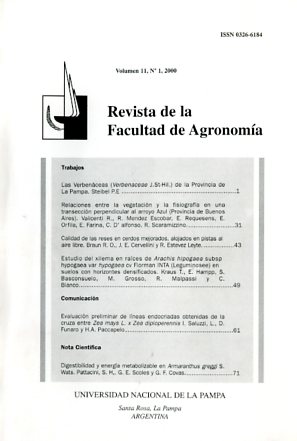Calidad de las reses en cerdos mejorados, alojados en pistas al aire libre
Palabras clave:
Cerdos en crecimiento-terminación, calidad de las reses, rodeos mejoradosResumen
Se controlaron dos grupos de cerdos capones provenientes de un rodeo genéticamente mejorado (A; n= 60), y el otro de un rodeo no mejorado (B; n= 60). El objetivo del trabajo fue evaluar el rendimiento de la res, el porcentaje (%) de magro y el espesor de grasa dorsal en ambos grupos y, en el grupo mejorado determinar si el % de magro y el espesor de grasa dorsal puede ser predicho por el rendimiento de la res. Los grupos se alimentaron desde los 50 kg de peso vivo (P. V.) hasta el peso de faena, 102 kg de P.V., durante 70 dfas, en 4 pistas de cemento (dos pistas por grupo) agrupados de a 3) cerdos. A ambos grupos se les suministró una ración ad-libitum cuya composición fue de: 14% de proteína bruta (P. B.), 3100 Kcal. de energía digestible por kilogramo (EDlkg), 0,75% de Ca; 0,50% de P y 0,83% de Iisina. Los resultados indicaron diferencias significativas entre tratamientos en los parámetros medidos: rendimiento de la res (%) (p<0,05) A= 76,33 +- 3,00; B= 78,47 +- 3,32; magro en porcentaje (p<0,01) A= 48,00 +- 2,61, B= 41,00 +- 2,41; espesor de grasa dorsal en mm (p<0,01) A= 15,89 +- 2,80, B= 23,76 +- 3,76. Las regresiones lineal simple y cuadrática para el porcentaje de tejido magro en función del rendimiento no fueron significativas (r=0,037 y r=0,13 respectivamente), tampoco lo fueron para el espesor de grasa dorsal (r= 0,105 y r= 0,106). Es importante destacar la composición estructural de las reses provenientes de cerdos mejorados, posibilidad que incrementa significativamente el precio del producto y también la eficiencia productiva.
Descargas
Citas
CARDEN, A. 1995. Estación de Pruebes de Reproductores Porcinos. Convenio INTA - Mejoramiento Genético Porcino (MGP). Vol. 1 N° 1. Argentina.
CARDEN, A., P. GOENAGA y M. LLOVERAS. 19968 . Evaluación de sondas ópticas automáticas para predecir el contenido de magro en canales porcinas. Informe Técnico N° 144. EEA, INTA Pergamino. Argentina.
CARDEN, A., P. GOENAGA y M. LLOVERAS. 1996b . Informe Técnico N° 311. EEA, INTA Pergamino. Argentina.
DE CARO, A Y C. BASSO. 1997. Mercados y comercialización en Producción Porcina, estrategias para una actividad sustentable. Vieites, M. Ed. Hemisferio Sur, 506, p.
GOENAGA, P. 1995. Estación de Pruebas de Reproductores Porcinos. Convenio INTA - Mejoramiento Genético Porcino(MGP). 1 N°3.
Resolución N° 891.94. Diario Oficial. Secretaria de Agricultura, Ganadería y Pesca de la Nación. Argentina.
SOBESTIANSKY, J., Y. WENTZ, P. DA SILVEIRA y L. SESTI. 1998. Suinocultura intensiva. Brasil. EMBRAPA , 388 p.
VIEITES, M. 1997. Producción Porcina. Estrategias para una actividad sustentable. Ed. Hemisferio Sur, 506p.
WHITTEMORE, C. 1~. Ciencia Y Práctica de la Producción Porcina. Ed. Acribia, S.A., 647 p.
Descargas
Publicado
Número
Sección
Licencia
La Editorial de la Universidad Nacional de La Pampa (EdUNLPam) exigirá a los/as autores/as la firma del siguiente documento:
La EdUNLPam lleva a cabo la publicación del artículo: (Título del Artículo) en SEMIÁRIDA Rev.Fac.Agron UNLPam ISSN 2362-4337 (impresa) ISSN 2408-4077 (en línea), del cual el/los abajo firmantes son autores de una o más partes. En el mismo acto, el/los autores entregan exclusivamente a la EdUNLPam todos sus derechos protegidos por las leyes de propiedad intelectual que rigen en la Argentina para reproducir, publicar, editar, fijar, comunicar y transmitir públicamente en cualquier formato o medio impreso o electrónico, inclusive internet, el artículo enviado a publicación e incluirlo en índices o bases de datos nacionales e internacionales. A cambio, la EdUNLPam entrega a los autores la autorización para la publicación o reimpresión con ines académicos y educativos en cualquier libro o medio de divulgación, con la sola obligación de citar el artículo original publicado en la EdUNLPam. Cada autor acuerda en que el material provisto a la EdUNLPam es un trabajo original, que no ha sido impreso o publicado en cualquier otro medio con anterioridad y que no vulnera derechos de terceros. El Primer autor tendrá la posibilidad de leer y corregir el artículo ya editado como “prueba de galera”, pero si el autor no devolviera esas correcciones de la prueba de galera dentro del tiempo especificado, el proceso de producción y publicación podrá proseguir sin la aprobación del autor. El/los autor/es no recibirán compensación monetaria de la EdUNLPam por el uso del material contenido en este artículo y asumen la responsabilidad de las opiniones vertidas en él.






.png)



22.png)


.jpg)




.jpg)
10.png)



